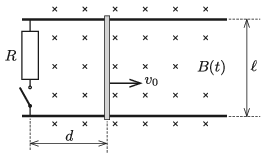 Problem P. 5369. (December 2021)
Problem P. 5369. (December 2021)
P. 5369. There are two parallel metal rails in a horizontal plane, at a distance of \(\displaystyle \ell\). The left ends of the rails are connected with a resistor of resistance \(\displaystyle R\) and a switch as shown in the figure. The arrangement is in vertical uniform magnetic field which varies with time according to the following relation: \(\displaystyle B(t)=B_0+kt\), where \(\displaystyle B_0\) and \(\displaystyle k\) are known constants.
Perpendicular to the rails, a metal rod is placed at a distance of \(\displaystyle d\) from the switch, to the right side of the switch. The resistance of the rails and the metal rod is negligible. At time \(\displaystyle t=0\) the switch is closed and we begin to move the rod in the horizontal plane perpendicularly to the rod, at a constant speed of \(\displaystyle v_0\). Determine the current flowing in the rod at time \(\displaystyle t\).

(5 pont)
Deadline expired on January 17, 2022.
Sorry, the solution is available only in Hungarian. Google translation
Megoldás. Az adott elrendezésben egyszerre lép fel a nyugalmi és a mozgási indukció jelensége. A fémpálca a \(\displaystyle t\) időpillanatban \(\displaystyle d+v_0t\) távol van a kapcsolótól és az ellenállástól, tehát a pálca által képezett zárt hurok területe \(\displaystyle A(t)=(d+v_0t)\ell,\) aminek változási sebessége:
\(\displaystyle \frac{\Delta A}{\Delta t}=v_0\ell.\)
Ha ezt a változási sebességet megszorozzuk a mágneses indukció pillanatnyi értékével,
\(\displaystyle U_1=\frac{\Delta A}{\Delta t}\cdot B(t)=v_0\ell(B_0+kt)\)
indukált feszültséget kapunk. Ez a mozgási indukció járuléka.
Másrészt az \(\displaystyle A(t)\) területű téglalapon a mágneses indukció \(\displaystyle \frac{\Delta B(t)}{\Delta t}=k\) változási sebességével arányos feszültség jön létre:
\(\displaystyle U_2=k\cdot A(t)=k\ell(d+v_0t).\)
Ez a nyugalmi indukció járuléka.
A záródó vezetőben folyó áram erősségét a kétféle feszültség összege határozza meg:
\(\displaystyle I(t)=\frac{U_1+U_2}{R}=\frac{\ell}{R}(B_0v_0+kd+2kv_0t).\)
Statistics:
38 students sent a solution. 5 points: Antalóczy Szabolcs, Bacsó Dániel, Barna Benedek, Bencz Benedek, Biebel Botond, Dóra Márton, Katona Attila Zoltán, Kürti Gergely, Molnár Kristóf, Mozolai Bende Bruno, Nemeskéri Dániel, Schmercz Blanka, Somlán Gellért, Téglás Panna, Toronyi András. 4 points: Kertész Balázs, Yokota Adan. 3 points: 4 students. 2 points: 8 students. 1 point: 1 student. 0 point: 1 student. Unfair, not evaluated: 6 solutionss.
Problems in Physics of KöMaL, December 2021
